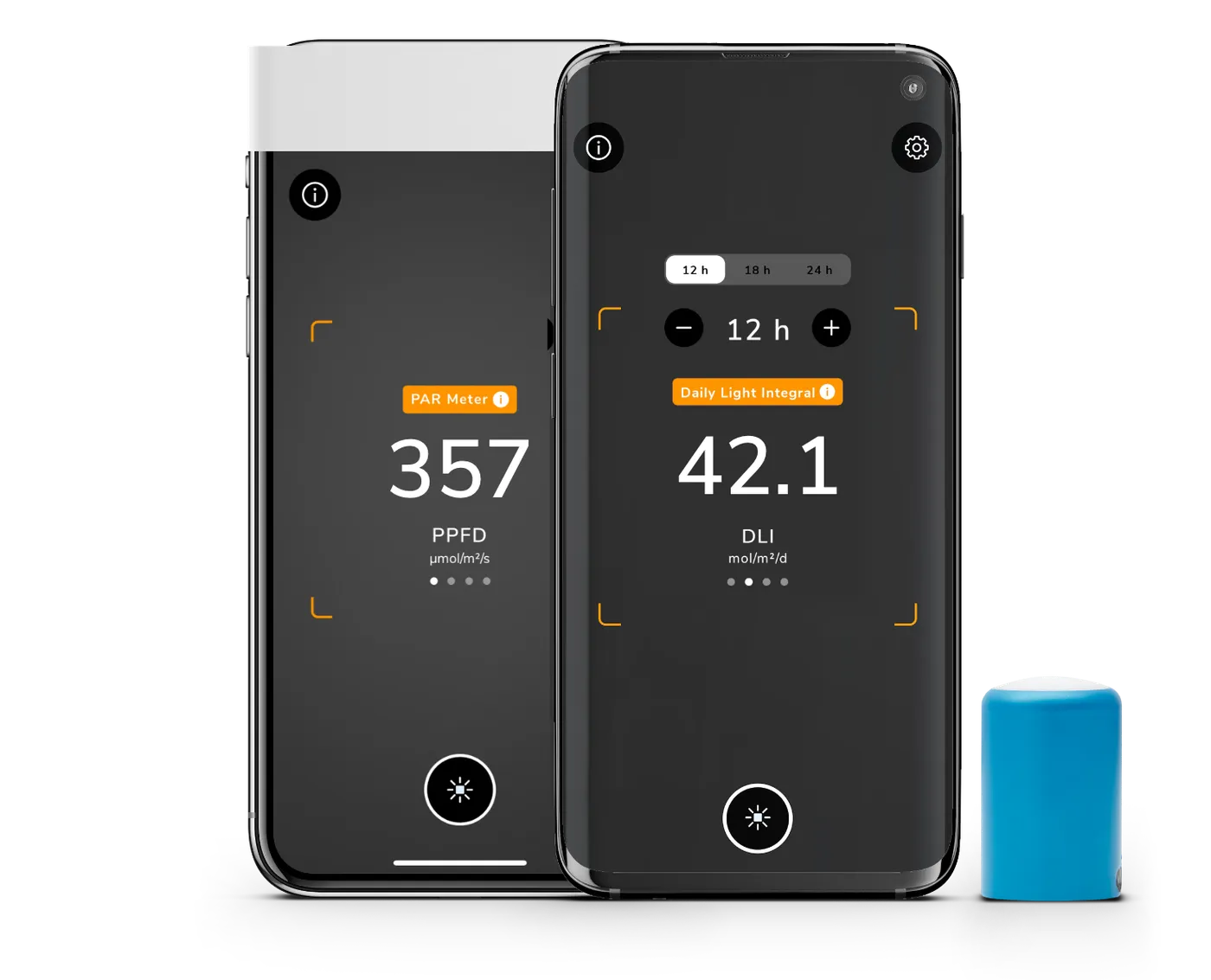
Auto-Translate
It's easy to watch a YouTube video of a master grower cultivating award-winning flowers. The plants are beyond healthy, and the branches bend under the weight of the resinous buds — everything looks so natural.
YouTube personalities and other highly respected cultivators repeat the same mantra — the more light, the better the growth. However, the science behind lighting for plants says otherwise.
When it comes to lighting, one of the most significant interdependencies that most growers don't know about is the relationship between the DLI, PPFD, and PAR. As you monitor these values, you can optimize the PPFD and PAR to reach the best possible DLI for your cannabis plants.
Read along to understand how DLI, PPFD, and PAR work, and how you can increase your garden’s efficiency with the help of our Plant Lighting Calculator.
Please mind that the following examples are illustrated for growing cannabis. However, the science behind is the same for every green, leafy plant.
Contents
The Vegetative Stage: 24-Hours Versus 18-Hours
Cannabis plants are photoperiodic, which means they react to the increase and decrease in light. Researchers attribute this phenomenon to seasonal changes, such as the increase in light in Spring and the reduction in light in Fall.
Cannabis, as you may know, will continue to produce foliage in the vegetative stage if the lighting remains over 12-hours per 24-hours. Cannabis growers worldwide embrace the idea that 18-hours of light is the minimum that a plant needs to vegetate continuously. Alternatively, others claim that 24-hours of continuous light dramatically increases growth rates.
Who's correct?
Ultimately, neither are correct. Blanket statements such as these do not help you fine-tune the cannabis plants in your environment. Instead, you'll need to adjust your lighting or the duration of light that your plants receive to optimize your cannabis garden.

Before showing you how to determine the duration of light that your plants need, let's do an overview of DLI, PPFD, and PAR.
DLI
The Daily Light Integral is a value that describes the number of particles of light (photosynthetically active photons) that land on a predetermined space over 24-hours. The predetermined area is a square meter that encompasses your plant(s).
PPFD
The Photosynthetic Photon Flux Density is the value that describes the number of particles of light in a specific PAR range that land on a square meter per second. As you can see, this is similar to that of the DLI; however, the PPFD describes a shorter timeframe.
PAR
Photosynthetic Active Radiation is the light range that plants can harness during photosynthesis. The PAR range is between 400-700nm and most notably contains the blue and red wavelengths.
How Much Light Does Your Plant Actually Need?
Research shows that all plants, even cannabis, have an optimal DLI. If you provide over the optimal DLI range, you can damage your plants, and waste money on your electricity bill. Alternatively, too low of a DLI can reduce your crop’s vigor, which means a lower yield.
With this in mind, how can you optimize the DLI for your cannabis plants? Luckily for you, researchers have mapped out the optimal DLI range for most plants — including cannabis. The optimal DLI range of cannabis is between 30 and 45, depending on the growth stage.
How Do Time and PPFD Affect Your Plants?
Now that you understand how the DLI affects your cannabis crop let's briefly touch upon PPFD and time.
Remember, the goal of PPFD and time is to reach the optimal range that your cannabis plants can handle. It's essential that you understand that all plants have a maximum PPFD range. If your plants surpass the maximum PPFD range, damage can occur.
As an indoor cultivator, you can control day and night intervals for your cannabis plants. While the lights are on, the leaves on the cannabis plants are receiving a specific number of PPFD per second.
Remember, the higher the light intensity — the higher the PPFD. The lower the light intensity, the lower the PPFD. Now, let's factor in time.
Here's an example: you use a low light intensity over a longer duration (24-hours). Alternatively, you can use a higher light intensity over a short period (14-hours).
The idea is that both of these scenarios provide the optimal DLI for your cannabis plants.
How To Optimize The DLI For Your Plants
You're probably scratching your head on how to configure an optimal DLI for your cannabis crop.
The answer is our Plant Lighting Calculator. First, you'll need to measure the available PPFD. This can be done with any PAR meter or our free PAR meter app. Next, select the type of plant that you're cultivating. In this case, select "Cannabis" and specify if it's in the flowering or vegetative stage. Lastly, input the light duration of your current lighting schedule.
Before you do anything, let's take a look at what you can change to influence a better DLI.
First, adjust the output of light by using the dimming switch on your ballast. If you're running a 1,000-watt bulb, you can reduce the output by 25-50%. Once you lower the light output, the PPFD will change. Measure the PPFD again using our app or any other PAR meter.
Now re-input your new PPFD into the Plant Lighting Calculator without changing the lighting duration. Voila – your DLI is in the optimal range.
Another way you can optimize your DLI without reducing your light’s wattage is to reduce the lighting duration until reaching the optimal DLI level.
Using our Plant Lighting Calculator allows you to quickly adjust your lighting and lighting duration to reach an optimal DLI. This saves you time, and it also protects your cannabis crop while reducing your overall electricity bill.
If you're ready to push your plants to the limit, whilst minimizing your electricity bill, now is the time to optimize your grow lighting like a pro with Photone (previously named Korona).


 Share This
Share This










